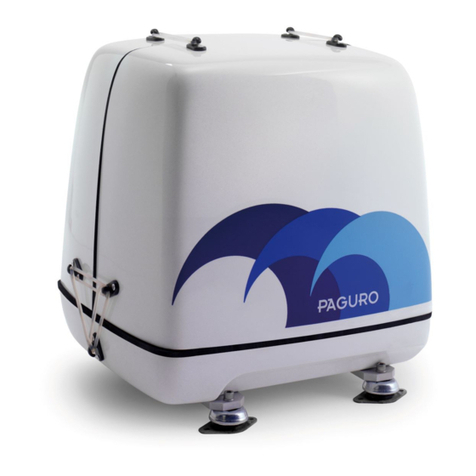
V.T.E. S.r.l. OWNERS MANUAL
PAGURO 12500
TABLE OF CONTENTS
GENERAL INFORMATIONS …………………………………………………………………………………………………………………………….... 3
SAFETY INSTRUCTIONS ………………………………………………………………………………………………………………………………. 5
INTRODUCTIONS / RECOMISSIONINGS ……………………………………………………………………………………………………………… 9
1. INSTALLATION ……………………………………………………………………………………………………………………………………………….. 10
EXTERNAL CONNECTIONS ………………………………………………………………………………………………………………………………. 12
VENTILATION ……………………………………………………………………………………………………………………………………………….. 12
LOCATION AND MOUNTINGS ………………………………………………………………………………………………………………………………. 13
FUEL LINES (Fuel Supply Line, Fuel return Line) …………………………………………………………………………………………..... 13
EXHAUST SYSTEM ………………………………………………………………………………………………………………………………………………… 14
RAW WATER COOLING SYSTEM (Siphon break, Raw Water Intake) …………………………………………………………… 15
STARTING BATTERY CONNECTION ………………………………………………………………………………………………………………. 16
MAIN OUTPUT VOLTAGE (230 V AC) ………………………………………………………………………………………………………………. 17
CONTROL PANEL ………………………………………………………………………………………………………………………………………………… 17
2. PREPARATION FOR INITIAL START-UP ………………………………………………………………………………………………………………. 18
DIESEL FUEL ………………………………………………………………………………………………………………………………………………… 18
ENGINE OIL SPECIFICATION ……………………………………………………………………………………………………………………………….. 18
PRE-START INSPECTION ……………………………………………………………………………………………………………………………….. 18
3. STARTING/STOPPING PROCEDURE ………………………………………………………………………………………………………………. 19
ELECTRIC START ………………………………………………………………………………………………………………………………………………… 19
PRE-HEATING ………………………………………………………………………………………………………………………………………………… 19
STARTING OPERATION ……………………………………………………………………………………………………………………………….. 19
OPERATING THE GENERATOR ……………………………………………………………………………………………………………………………….. 19
INITIAL START UP CHECKLIST ……………………………………………………………………………………………………………………………….. 19
STOPPING THE GENERATOR ……………………………………………………………………………………………………………………………….. 19
4. BREAK-IN PROCEDURE ……………………………………………………………………………………………………………………………….. 20
CHECK LIST ………………………………………………………………………………………………………………………………………………… 20
STOPPING THE GENERATOR ……………………………………………………………………………………………………………………………….. 20
5. MAINTENANCE SCHEDULE ……………………………………………………………………………………………………………………………….. 21
6. EXHAUST SYSTEM ………………………………………………………………………………………………………………………………………………… 22
EXHAUST SYSTEM PRECAUTIONS ………………………………………………………………………………………………………………. 23
7. COOLING SYSTEM ………………………………………………………………………………………………………………………………………………… 24
RAW WATER PUMP (inspecting/changing the raw water pump impeller) …………………………………………………………… 24
RAW WATER INTAKE STRAINER ……………………………………………………………………………………………………………………………….. 24
DRAINING THECOOLING SYSTEM ………………………………………………………………………………………………………………. 24
8. LUBRICATION SYSTEM ……………………………………………………………………………………………………………………………….. 24
ENGINE OIL ………………………………………………………………………………………………………………………………………………… 25
OILPRESSURE ………………………………………………………………………………………………………………………………………………… 25
OILCOOLER ………………………………………………………………………………………………………………………………………………… 25
OIL FILTER (Replacing the oil Filter) ………………………………………………………………………………………………………………. 25
CHECKING THE OIL ………………………………………………………………………………………………………………………………………………… 25
CHANGING THE OIL ………………………………………………………………………………………………………………………………………………… 25
DRAINING THE USED OIL ……………………………………………………………………………………………………………………………….. 25
ADDING NEW OIL ………………………………………………………………………………………………………………………………………………… 25
9. FUEL SYSTEM ………………………………………………………………………………………………………………………………………………... 25
DIESEL FUEL ………………………………………………………………………………………………………………………………………………… 25
FUEL ADDITIVES ………………………………………………………………………………………………………………………………………………… 25
CAREOF THE FUEL SUPPLY ……………………………………………………………………………………………………………………………….. 25
FUEL LIFT PUMP ………………………………………………………………………………………………………………………………………………… 25
FUEL FILTER (Replacing the Fuel filter) ………………………………………………………………………………………………………………. 25
FUEL SUPPLY LINE ………………………………………………………………………………………………………………………………………………... 26
FUEL FILTER OF THE WATER-SEPARATING TYPE ……………………………………………………………………………………………... 26
FUEL INJECTION PUMP ……………………………………………………………………………………………………………………………….. 26
FUEL SHUT-OFF SOLENOID ……………………………………………………………………………………………………………………………….. 26
BLEEDING THE FUEL SYSTEM ……………………………………………………………………………………………………………………………….. 26
SPARE PARTS ………………………………………………………………………………………………………………………………………………... 26
10. DC ELECTRICAL SYSTEM ……………………………………………………………………………………………………………………………….. 27
CONTROL PANEL ………………………………………………………………………………………………………………………………………………… 28
12 VOLT DC CONTROL CIRCUIT ……………………………………………………………………………………………………………………………….. 28
BATTERY (Battery Care, Checking the service Battery) ……………………………………………………………………………………………… 28
11. GENERATOR INFORMATION ……………………………………………………………………………………………………………………………….. 29
REQUIRED OPERATING SPEED ……………………………………………………………………………………………………………………………….. 29
GENERATOR MAINTENANCE ……………………………………………………………………………………………………………………………….. 29
12. GENERATOR TROUBLESHOOTING ………………………………………………………………………………………………………………. 29
13. SHORE POWER TRANSFER SWITCH ………………………………………………………………………………………………………………. 30
14. LAY UP AND RECOMISSIONING ……………………………………………………………………………………………………………………………….. 31
NOTE ……………………………………………………………………………………………………………………………………………………………....... 33






























